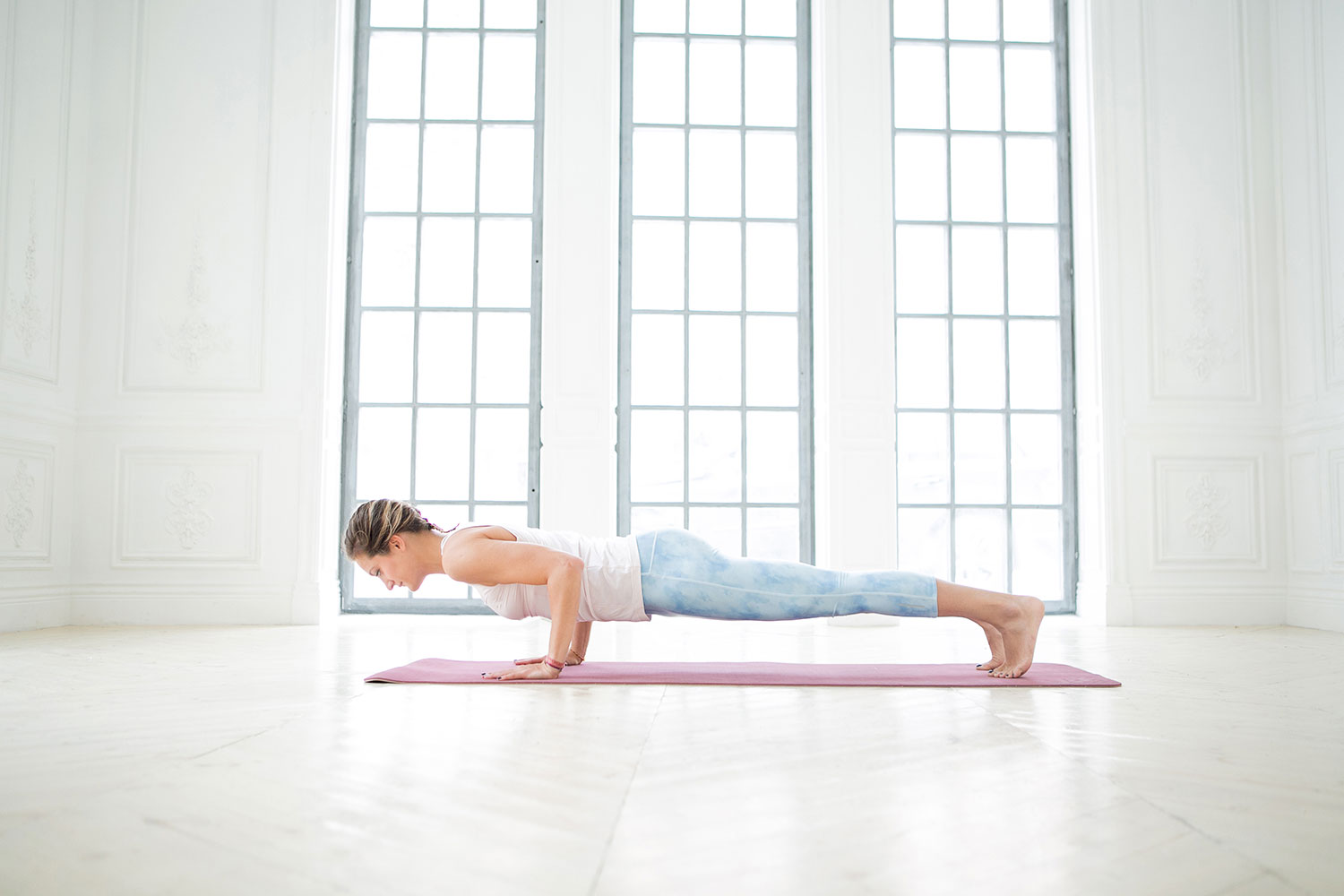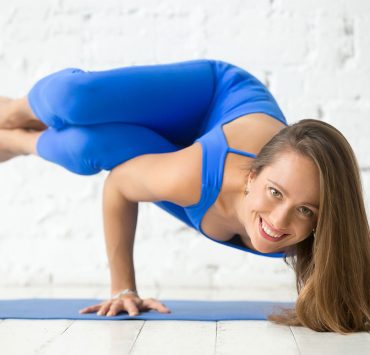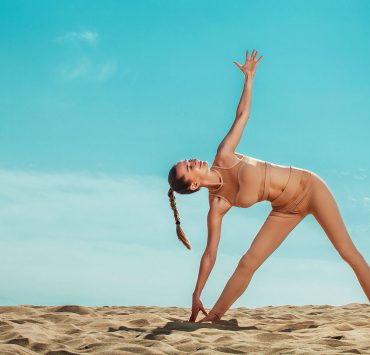
Andrea has been hosting yoga retreats in various locations worldwide…
One of the most frequently breezed-through poses in many yoga classes is Chaturanga Dandasana. We find it in most Ashtanga, Vinyasa, and Power Yoga classes and often in Hatha practice, too. Often referred to but not taught, Chaturanga becomes a means of transition rather than an asana in its own right. While it is certainly a pose that carries us to another, it holds incredible meaning and power as a stand-alone posture. A key asana in Surya Namaskar, or Sun Salutations, this pose is a part of the dynamic prayer that worships the sun. Yet even on its own, Chaturanga holds a deeper meaning we tend to miss in our day-to-day practice.
Meaning of Chaturanga Dandasana

Derived from Sanskrit, we can break the name down into four parts: chatur, meaning “four,” anga, meaning “limb,” danda, meaning “staff,” and asana, meaning “pose.” Stringed together we get the English translation: Four-Limbed Staff Pose.
Chaturanga originated as a way to come into a prostration, or pranam. A pranam can be seen as a salutation, or a bowing to life force. As such, Chaturanga is a powerful pose of surrender – a pose that brings us to bow down. Tantric scholars have translated early tantric texts in which Chaturanga has been noted. Translations show us that prostrations are seen as embodied meditations and acts of prayer, which is why Chaturanga fits quite naturally into Sun Salutations. Traditionally practiced at sunset or sunrise, Surya Namaskar has been a traditional means of revering the sun, Surya. Chaturanga in these traditional practices is therefore deeply acknowledged to be just as symbolic a pose as any of the others in this dynamic prayer.
Beyond The Physical

We do not often hear it spoken aloud in modern yoga classes but each asana of Surya Namaskar has an associated mantra. While not typical, each mantra can be repeated aloud as we come into each pose. The mantra associated with Chaturanga is “om pusne namaha” which translates to, “I bow to the giver of nourishment and strength.” With this in mind and spirit, Chaturanga is a pose that helps us to connect with that which gives us strength and energy – both inside and out. It is said to stimulate the manipura chakra, our energy center of confidence and self-esteem.
Founder of Seattle Yoga Arts, Denise Benitez wrote, “Chaturanga and other poses that demand such attention to the balance between effort and surrender can teach you dharana—concentration or focus.” Dharana is the sixth limb of yoga that helps us to develop our one-pointed attention. As we start to become more aware of Chaturanga as a pose in its own right, we can strengthen this ability to both harness strength and to surrender while holding this pose, even if only for a brief moment.
Yoga is not just repetition of few postures – it is more about the exploration and discovery of the subtle energies of life. Amit Ray
Chaturanga prepares us for Cobra Pose. As it is the posture in transition that leads us into an open-hearted surrender, it encourages us to release the thinking mind and to ground ourselves in the heart space. We are asked to let go of all that blocks us from complete openness, gratitude, appreciation, and oneness.
Instructions

Coming into Chaturanga can be done in a few ways. The following instructions refer to the pose as if we are practicing it in a traditional Sun Salutation sequence.
- Begin in Downward Facing Dog. Hands are planted into the ground, fingers spread wide. Tailbone pulls up towards the ceiling and the heels push down towards the ground. The head falls naturally and shoulders come away from the ears.
- Gently come into High Plank by engaging the core, bringing the heels forward while keeping the toes tucked, and bringing the shoulders in line with the elbows and wrists. Draw the navel up towards the spine to form one straight line from heels to the top of the head.
- On an exhalation, lower the upper body towards the floor while engaging the arms. The upper arms should come to be parallel to the ground and the shoulders should stay above the wrists. Shoulders should come away from the ears. Hold here for a moment.
- To transition through to Cobra, inhale as you gently lower the knees, chest, and chin towards the mat and then push through the arms to raise the upper body. Extend your feet so that your toes point backward and the tops of your feet rest on the mat. Draw the shoulders back to open the chest and adjust your hand positioning as necessary if discomfort in the back is present. Your thighs rest upon the mat. Gaze forward.
When practicing Chaturanga as a stand-alone asana, breathe continuously while holding the pose. During Surya Namaskar, the pose is performed on an exhalation.
Alternative Version

An alternative and slightly easier version of Chaturanga is to hold the pose while supporting the body through the knees. This might be an ideal first version for new yoga students.
- From Downward Facing Dog, come into High Plank position and then lower your knees to the mat. Hug your elbows into your sides as you lower your torso so that your upper arms are parallel to the floor. Your body should be in one straight line from thighs to the top of your head. Hold here for a moment.
- Come into Cobra by uncurling your toes and straightening your arms. Open the chest and allow the shoulders to fall naturally. Gaze forward.
Common Mistakes

There are a few common mistakes made while transitioning into Chaturanga that can cause pain and put unnecessary strain on the body. The first one is leading through the hips. If the hips drop towards the mat before the knees come down, this can cause strain and potentially injury to the back. There can also be a tendency to lead with the chest, which puts strain on the shoulders. Hand positioning is another alignment issue to watch out for; if hands are too close to the shoulders, the bend at the elbow will be sharper than the desirable 90 degree angle. The upper arm should be parallel to the mat and the shoulders lined up above the wrists to create that ideal angle.
When practicing Chaturanga Dandasana, it is crucial to move slowly to avoid injury. Starting with the alternative version of the pose, with knees grounded on the mat before coming into a low plank, will help to strengthen the core and upper body muscles required for the full pose.
Modifications with Props

It can be challenging to use props during Chaturanga while in the middle of a flow class, but if you are practicing on your own and wanting to explore this pose as a stand-alone, you can use props to support you.
- Use a block beneath your chest. Coming onto all flours, experiment with both long and short ends of the block to figure out which position is best suited for you. As you come into Chaturanga, allow the block to support your chest in low plank.
- If you are new to yoga, you can also experiment with a bolster by placing it lengthwise down your midline from chest to pelvis. This is a great support if you are looking to perfect your arm, elbow, and hand positioning.
- Another modification is to use a strap. This is not ideal in a flow sequence or when transitioning to Cobra or Upward Facing Dog, but it can be used to explore Chaturanga as a pose on its own. Make a loop with your strap and slide it around your arms, right above your elbows. Adjust the size of the loop so that when you bend your elbows your upper arms touch the sides of your ribs. Start in High Plank and then come to your knees. Slowly lower down into Chaturanga, holding for a couple of breath cycles before pushing back to release the pose.
Contraindications
Chaturanga Dandasana is contraindicated with pregnancy, carpal tunnel, and wrist, shoulder, and back injuries. Whenever you are starting a new workout program, it is important to consult with a healthcare practitioner to ensure new poses and workouts are right for you.
Benefits

This pose engages the entire body and helps to develop strength of a variety of muscles. One key area that is engaged as we perform Chaturanga is the core; abdominals are strengthened as we learn to control and hold this pose. Chaturanga also strengthens the arms and wrists and is a great preparatory pose for arm balances.
Not only does it work the physical body, Chaturanga is a great pose for strengthening our focus and concentration. It requires us to harness our inner strength and confidence as we lower the body with control before coming into an open-hearted pose of surrender.
Yoga is a dance between control and surrender. Joel Kramer
When we bring mindfulness and focus to Chaturanga Dandasana, we see that this pose stands quite sufficiently on its own while also being a movement towards the earth and towards consciousness – a movement towards the “giver of nourishment and strength.” As we practice this pose time and time again with its lesser-known meanings in heart and mind, we might find that it beckons us towards that sweet spot between control and surrender. At the core of it, we come to learn that Chaturanga embodies what it means to practice yoga.
What's Your Reaction?
Andrea has been hosting yoga retreats in various locations worldwide since 2003 and continues to encourage her students to live as the best version of themselves. Yogic living provides the framework for her informative writing, which is chock-full of beneficial tips and tricks.














